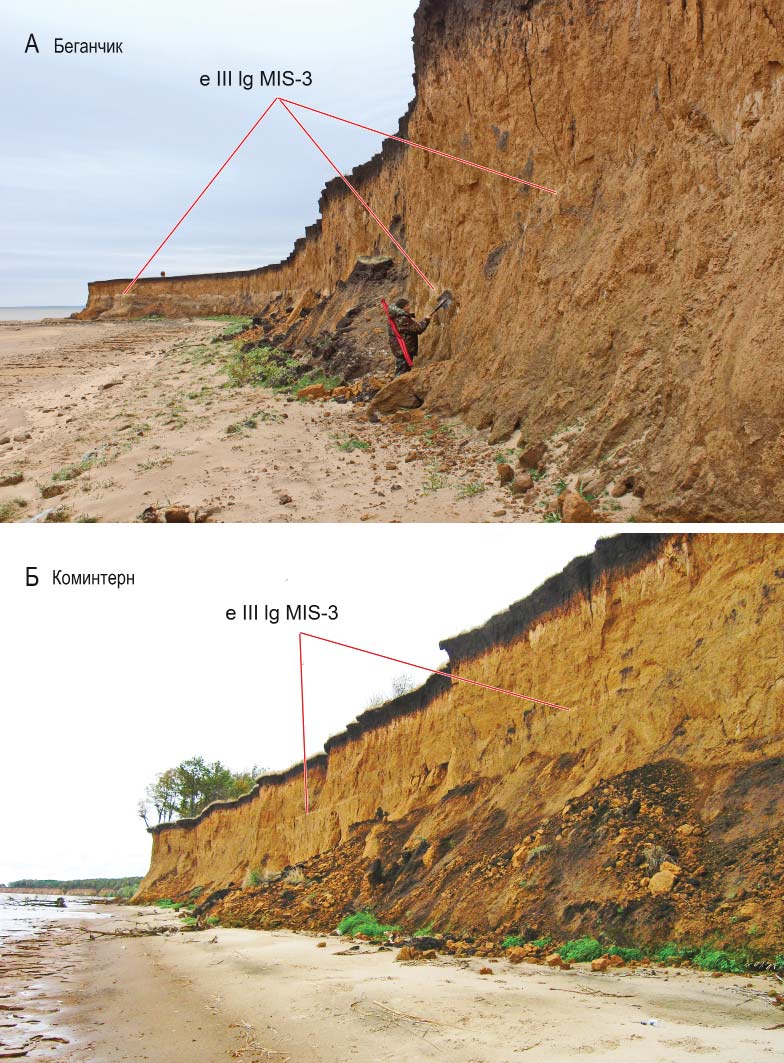THE STONE AGE SITE AND PALEONTOLOGICAL LOCATION NEAR THE VILLAGE OF COMINTERN (AT THE CONFLUENCE OF THE KAMA AND VOLGA): RESEARCH RESULTS 2020
DOI:
https://doi.org/10.24852/2587-6112.2021.1.262.279Keywords:
archaeology, paleontology, Volga and Kama confluence, Quaternary, terminal Palaeolithic, stone artefacts, Ust’-Kamaskaya culture, fossil faunal complexes, Equus aff. Mosbachensis, Trogontherium cuvieriAbstract
The paper features the results of archaeological and paleontological research in the left bank of the Kuibyshev reservoir, at the mouth of the Aktai River (Republic of Tatarstan). Bones and teeth of fossil mammals (223 fi nds) were collected under the cliff of the reservoir for 300 m. The following species were identifi ed: mammoth, woolly rhinoceros, bison, tur, horse, reindeer, elk, fox, marmot etc., which may belong to the Upper Pleistocene or Khazar faunal complexes. Also the bones of the limb of a large horse were collected, which were identifi ed as a horse of Mosbach of the middle Neo-Pleistocene Singil’ faunal complex existed in the Volga region about 400 thousand years ago. Upper incisor of a giant beaver and the large jaws of a Pleistocene wild boar were also found at the Comintern site and were probably attribute to Singil’ fauna. At the same time, the authors collected 39 artifacts from fl int and one from quartzite, belonging to the Ust’-Kamaskaya culture of the terminal Paleolithic. Of particular importance were two localities fi xed by the authors in stratifi ed sections – fl int fl ake and rhinoceros limb bone, which lay within the buried soil formed during the warming period of the Middle Valdai (MIS-3).
References
Starostin, P. N. (ed.). 1986. Arkheologicheskaya karta Tatarskoy ASSR. Zapadnoe Zakam’e (Archaeological Map of the Tatar ASSR. Western Trans-Kama Region) I. Kazan: Institute of Language, Literature and History, Kazan Branch of the USSR Academy of Sciences (in Russian).
Aghajanyan, A. K., Glushankova N. I. 2017. In Stratigrafi ya. Geologicheskaya Korreliatsia (Stratigraphy. Geological Correlation) 25 (4). Moscow: Nauka Publ., 89–107 (in Russian).
Alekseeva, L. I. 1990. Teriofauna Verkhnego Pleistotsena Vostochnoi Evropy (Krupnye Mlekopitaiushchie) (Teriofauna of the Upper Pleistocene of Eastern Europe (Large Mammals). Moscow: Nauka Publ. (in Russian).
Bryusov, A. Ya. 1940. In Bulleten Komissii po izucheniyu chetvertichnogo perioda (Bulletin of the Commission for the Study of the Quaternary period) 6–7. Moscow; Leningrad: Academy of Sciences of the USSR Publ., 76–78 (in Russian).
Mikhailov, E. P., Berezina, N. S. (eds.). 2015. Arkheologicheskaya Karta Chuvashskoy Respubliki: Nauchno–Spravochnoe Izdanie (Archaeological Map of the Chuvash Republic: Scientifi c Reference Publication) 3. Cheboksary: Chuvash Publishing House (in Russian).
Berezin A. Yu. 2012. Nakhodki Pozdnei Chetvertichnoi Fauny v Severnoi Chasti Privolzhskoi Vozvyshennosti v Svete Vozmozhnogo Zaseleniya Drevnim Chelovekom Chuvashskogo Povoljia: doklad na itogovoi nauchnoi sessii Chuvashskogo gosudarstvennogo institute gumanitarnykh nauk (Findings of Late Quaternary Fauna in the Northern Part of the Volga Upland in the Light of the Possible Settlement of the Chuvash Volga Region by Ancient Man: report at the fi nal scientifi c session of the Chuvash State Institute of Humanities on the results of work for 2011). Cheboksary: Chuvash State Institute for the Humanities Sciences (in Russian).
Galimova, M. Sh. 2001. Pamiatniki Pozdnego Paleolita i Mezolita v Ust’e Reki Kamy (Late Palaeolithic and Mesolithic Sites in the Mouth of the Kama River). Moscow–Kazan: Ianus–K Publ. (in Russian).
Galimova, M. Sh., Berezina, N. S., Berezin, A. Yu. 2018. In Povolzhskaya Arkheologia (Volga River Region Archaeology) (3), 8–29 (in Russian).
Garutt, N. V. 1998. Woolly Rhinoceros: Morphology, Systematics, Geological Signifi cance: diss. ... candidate of Geol.-mineral. Sciences. Saint Petersburg (in Russian).
Glushankova, N. I. 2015. In Litologiia I Poleznye Iskopaemye (Lithology and Mineral Resources) 50 (3), 192–202 (in Russian).
Kazakov, E. P. 2011. Pamiatniki epokhi kamnia v Zakam’e (Sites of the Stone Age in the Trans–Kama Area). Series Arkheologia Povolzhia i Urala. Materialy i issledovaniia (Volga and the Urals Archaeology. Materials and Studies) 1 Kazan: Foliant Publ. (in Russian).
Lyganov, A. V. 2017. In Povolzhskaya Arkheologia (Volga River Region Archaeology) (3), 97–116 (in Russian).
Mirchink, G. F. 1932. In Vestnik Akademii Nauk SSSR (Bulletin of the Academy of Sciences of the USSR) 3. Moscow: Academy of Sciences of the USSR, 39–42 (in Russian).
Nikitin, V. V. 1996. Kamennyi Vek Mariiskogo Kraya (Stone Age of Mari Land) Series Trudy Mariiskoi Arheologicheskoi Ekspeditsii (Proceedings of Mari Archaeological Expedition) IV. Yoshkar–Ola: MarNII (in Russian).
Panichkina, M. Z. 1953. In Rybakov, B. A. (ed.). Sovetskaya Arkheologia (Soviet Archaeology) XVIII. Moscow: Academy of Sciences of the USSR, 232–264 (in Russian).
Petrova, E. A. 2009. Istoriia formirovaniia fauny krupnykh mlekopitaiushchikh Volkhsko-Kamskogo regiona v srednem i pozdnem neiopleistotsene (The history of formation of the large mammals fauna of the Volga and Kama Region during the Middle and Late Neo-Pleistocene). Cand. of Biol. Sc. Thesis. Saint Retersburg (in Russian).
In Trudy Zoologicheskogo institute RAN (Proceedings of the Zoological Institute of the Russian Academy of Sciences) 313 (1), 58–67 (in Russian).
Polyakov, I. S. 1880. Antropologicheskaya poezdka v Tsentral’nuyu I Vostochnuyu Rossiyu (Anthropologic Jorney to Central and Eastern Russia) Prilozhenie k Tomu XXXVII Zapisok Imperatorskoy Akademii Nauk (Appendix to Volume 37 of the Notes of the Imperial Academy of Sciences) 1. Saint Petersburg: Typography of the Imperial Academy of Sciences (in Russian).
Khalikov, A. Kh. 1961. In Trudy Mariiskogo Nauchno-Issledovatel’skogo Instituta (Proceedings of the Mari Research Institute) 16. Yoshkar-Ola: Mari Publishing House, 139–162 (in Russian).
Chizhevsky, A. A., Galimova, M. Sh., Mel’nikov, L. V., Khisamutdinova, R. A. 2011. In Galimova, M. Sh. (ed.). Arkheologiia i Estestvennye Nauki Tatarstana (Archaeology and Natural Sciences of Tatarstan) 4. Kazan: Foliant Publ., 336–367 (in Russian).
Cordova, C. E., Vyazov, L. A, Blinnikov, M. S. Late Pleistocene Pedostratigraphic Sequence and Paleolithic–Mesolithic Occupations at the Beganchik Locality, Middle Volga Region, Russia (Invited Presentation). In Geological Society of America Abstracts with Programs. V. 52. No. 6. 2020. (URL: https://gsa.confex.com/gsa/2020AM/webprogram/Paper358757.html. Date of access14.02.2021) doi: 10.1130/abs/2020AM-358757

Downloads
Published
How to Cite
Issue
Section
License
Copyright (c) 2021 M. Sh. Galimova, A. Yu. Berezin, N. S. Berezina, E. P. Mikhailov

This work is licensed under a Creative Commons Attribution-NonCommercial 4.0 International License.







